ReportWorX supports the following parameters:
Manual
Fixed list
Dynamic list
Expression
DateTime
Trigger
User Identity
Cell reference
Tag
Machine local
Machine server
The supported data types are the following:
Boolean
Int
Double
Datetime
String
Some parameters can reference other parameters, but no parameter can reference itself in one of its expressions.
All parameters share the following fields:
Name – automatically generated by ReportWorX and it cannot be changed.
DisplayName – a friendly name that can be modified by the user.
Description – a field where you can write details about the parameter in case you need it.
Type – the type of the parameter.
Data type – the data type of the parameter.

The embedded expression editor is a dialog box that you can reach from the parameter configuration tab.
It allows you to generate piece of code that you can copy and paste in the headers or footers of the Excel worksheet to evaluate and show the value in that specific part of the worksheet.
In general, this feature is used for formatting purposes.
For example, the templates used to generate the project reporting reports are using this feature.
It is s the simplest parameter that you can provide a default value that is going to be shown when you will have to select its value.
The default value is an expression, you can edit the expression in the expression editor or directly in the textbox.
Manual parameters are always going to show up in the parameters’ selection window the download operation if they are used in the report.
The manual parameter’s default value cannot reference other parameters, but manual parameter can be referenced in the expression of other parameters that allow parameters reference.
General Configurator dialog

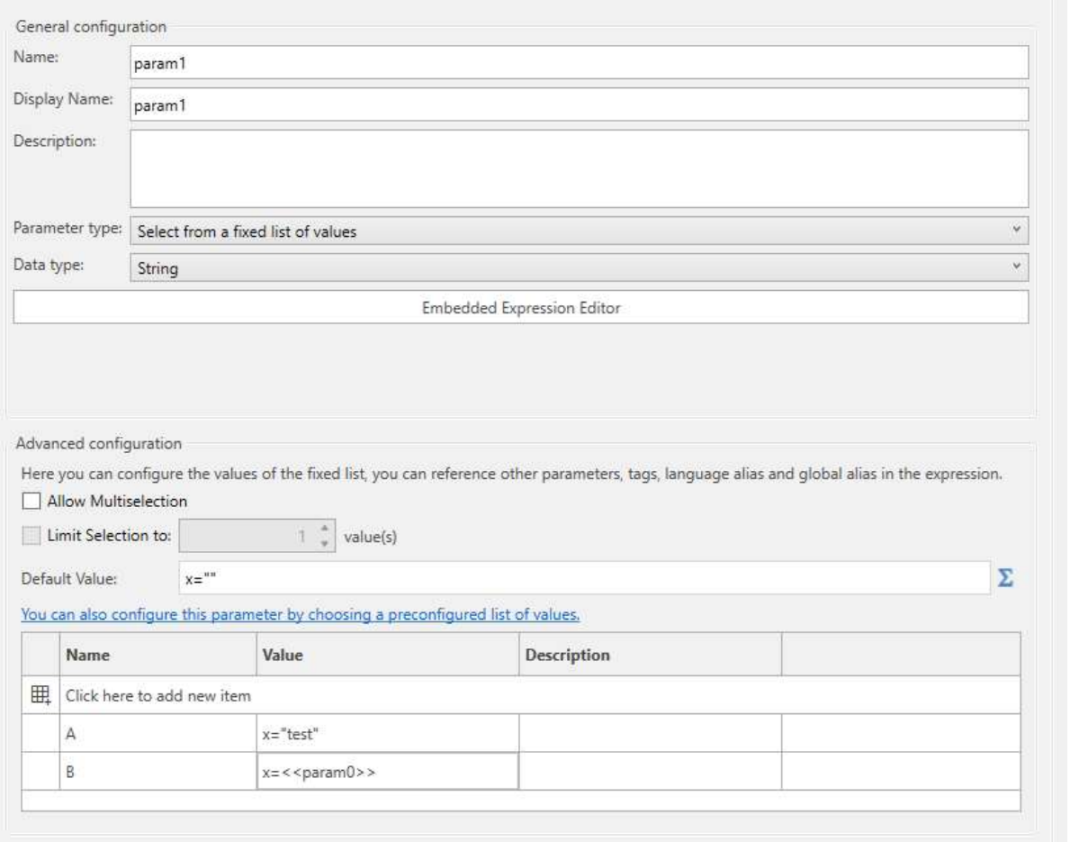
The fixed list parameters allow you to create a list of predefined options that are going to be available for selection when you download the data or run the report.
Fixed list parameters are always going to show up in the parameters’ selection window before the download operation if they are used in the report.
The options are characterized by a name and a value, the value is an expression that you can edit in the expression editor or directly in the textbox.
The value expression can reference other parameters. If a fixed list is referenced by another parameter, the selected value is going to be used as its value.
For example:
If we have an expression parameter with the following expression:
X=<<param0>> + 55
where <<param0>> is a fixed list, with the following options:
A,55
B,66
C,77
And you select C, the value of <<param0>> is 77, so the result of x=<<param0>> + 55 is going to be 132.
It is possible to fill the fixed list parameter with some predefined.
When dealing with a fixed list parameter, it is possible to check the Allow multiselection option, and if needed, you can limit the selection up to a specific value.

It is also possible to directly bind an expression parameter in the available option without writing an expression; this possibility is still present for backward compatibility, but since it is possible to directly reference parameters in the expression of an option, we encourage you not to use this feature anymore.
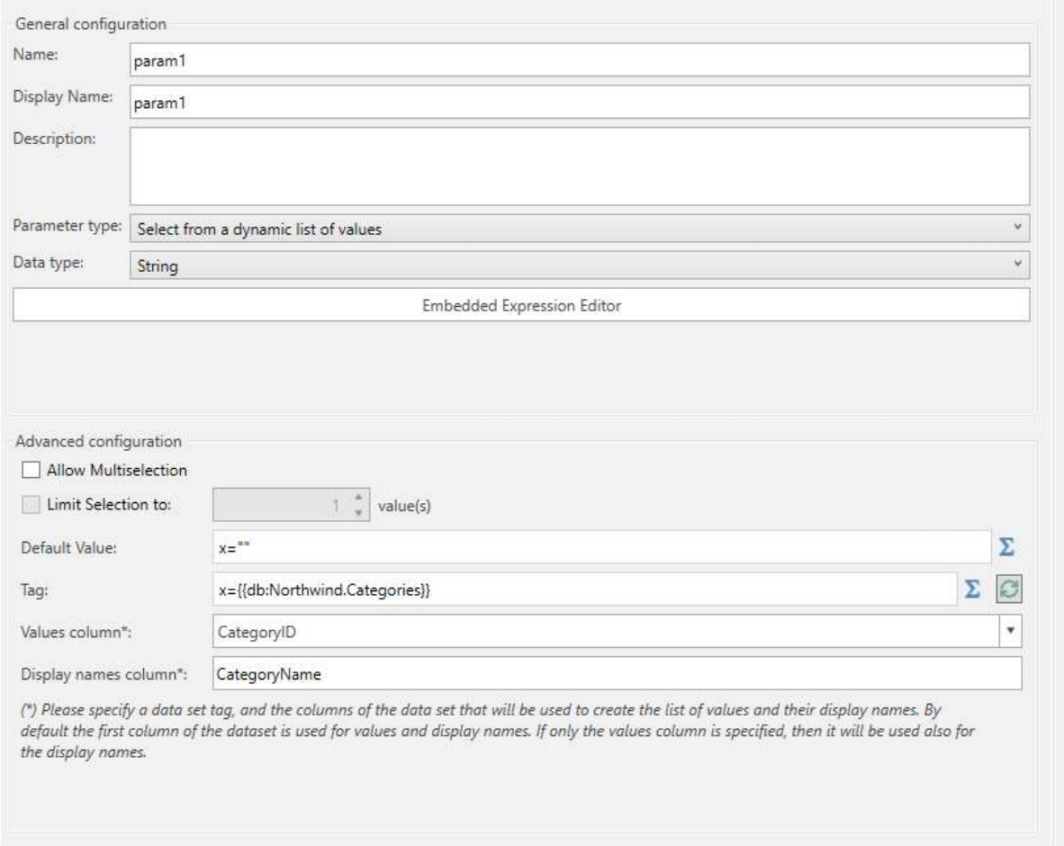
The dynamic list is a parameter that works like the fixed list parameter, but the configuration is different.
You can provide a default value.
Dynamic list parameters are always going to show up in the parameters’ selection window before the download operation if they are used in the report.
You can specify a dataset tag. Note that the tag can reference other parameters. Once you have provided the tag, you click on the refresh button, and the combo box of Values column will show you the columns of the specified dataset.
The values column represents the value that you are going to use.
The display name column can specify a column that helps you select the proper value by displaying a friendly name.
In the case shown in the screenshot, instead of showing the CategoryID, we are going to show the CategoryName; but the selected value is going to be an id and not a name.
When dealing with a dynamic list parameter, it is possible to check the Allow multiselection option, and if needed, you can limit the selection up to a specific value.
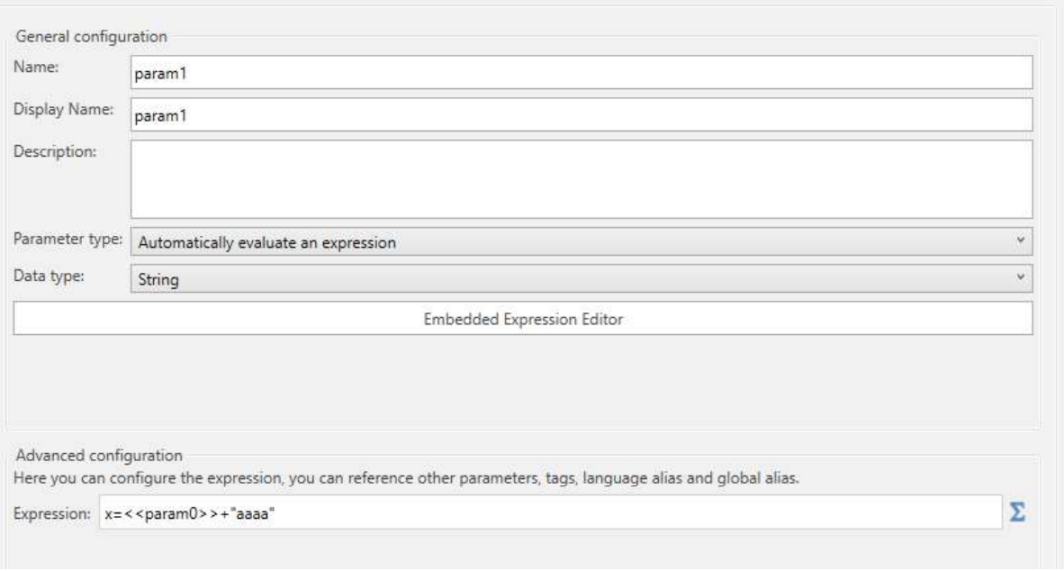
The expression parameter is like the manual parameter, but here you can specify an expression that is going to be evaluated once the parameter is used somewhere in the report.
Expression parameters are not going to show up in the parameters’ selection window.
Expression parameter’s expression can reference other parameters.
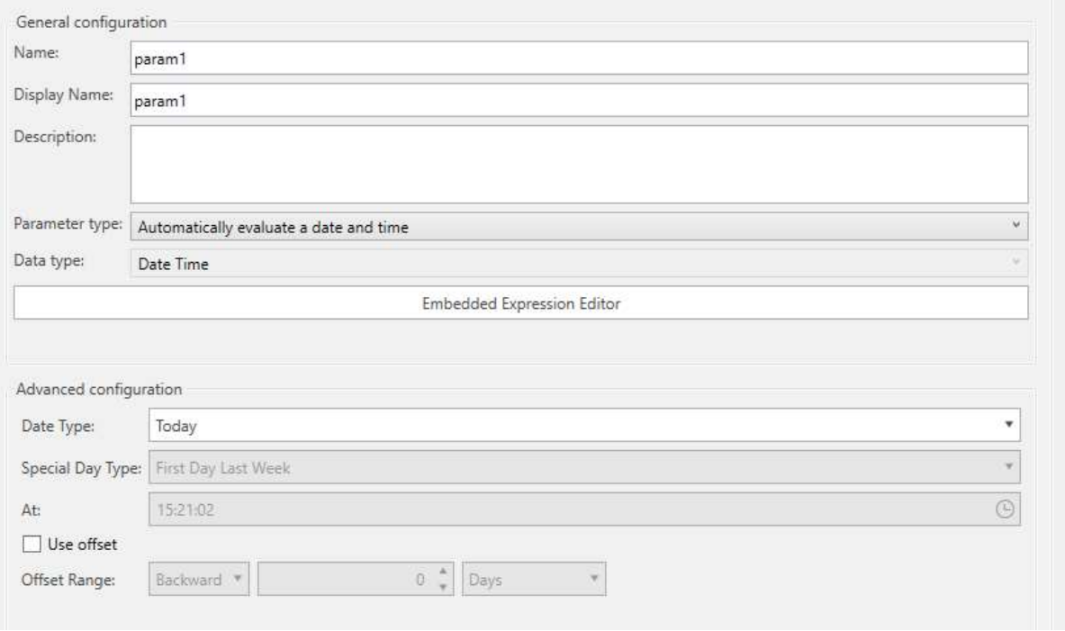
The datetime parameter allow you to configure complex datetime settings.
The datatime parameter’s data type is datetime and cannot be changed.
The available Date type are the following:
Today
Today at fixed time
Special day
If you select Today, you can choose to use enable the Use offset option and specify an Offset Range.
The offset can be specified in:
Months
Days
Hours
Minutes
Seconds
And you can choose the offset to be backward or forward.
If you select Today at fixed time, you can specify the time that you prefer.
You can still use the offset in the same way of Today.
If you select Special Day, you can select the Special Day Type, the available values are:
First Day Last Week
First Day Current Week
First Day Last Month
First Day Current Month
First Day Last Week
Last Day Last Week
Last Day Current Week
Last Day Last Month
Last Day Current Month
The Special Day allows you to quickly obtain those datetime values without the need of writing complex expressions.
Datetime parameter does not allow reference to other parameters since there is no editable expression, datetime parameters can be referenced by other parameters.

The trigger parameter allows you to access the trigger information if the report generation has been triggered by an event.
You can specify the Trigger type and choose between one of these type:
Common
Alarm trigger event
Data trigger event
Database trigger event
File trigger event
NT trigger event
Trigger time event
Trigger related values
Once you select the Trigger type, you can select the trigger field you are interested.
Eventtld
EventType
EventClass
SourceName
Time
ReceiveTime
Severity
ChangeMask
NewState
ActiveTime
Actorld
ConditionName
OriginalSource
TriggerCount
Alarm trigger event
Message
Source
Category
Type
AlarmSeverity
ConditionName
SubConditionName
ActorID
Data trigger event
Timestamp
Value
Quality
PreviousTimestamp
PreviousValue
PreviousQuality
SourceTag
Database trigger event
ActivationTime
NumRecords
Name
TableName
File trigger event
ActivationTime
RootFolder
FileCause
ActionCause
NT trigger event
ActivationTime
NumEvents
Category
Subcategory
Trigger time event
TimeScheduled
TimeNotOffset
Trigger related values
RelatedValue01
RelatedTimestamp01
RelatedQuality01
...
RelatedValue20
RelatedTimestamp20
RelatedQuality20
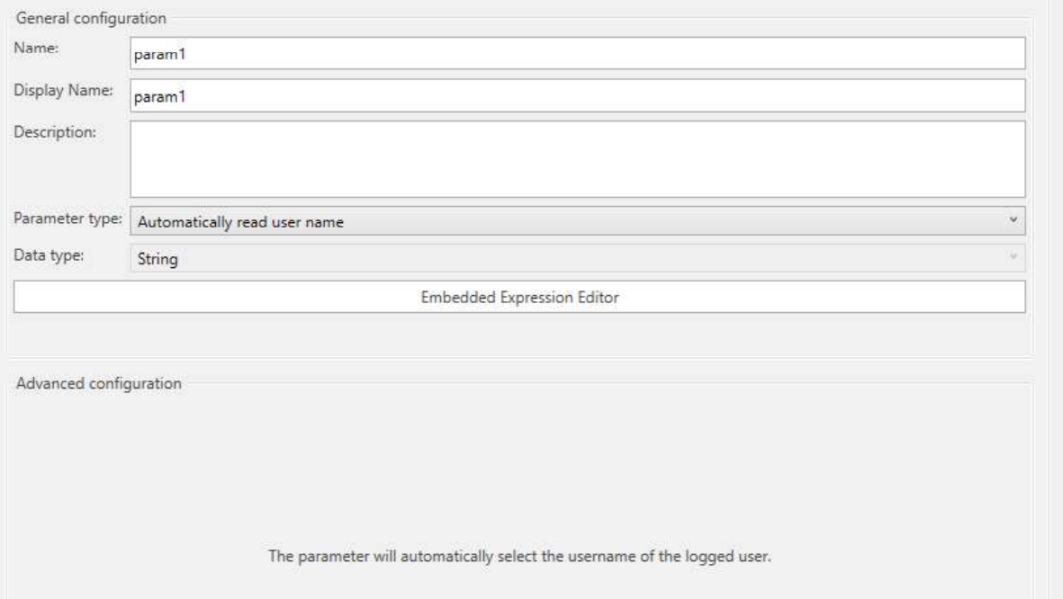
The user identity parameter does not allow you any configuration, it is going to automatically read the currently logged in username.
The data type is String and cannot be changed.
The user identity parameter does not allow reference to other parameters since there is no expression, user identity parameters can be referenced by other parameters.
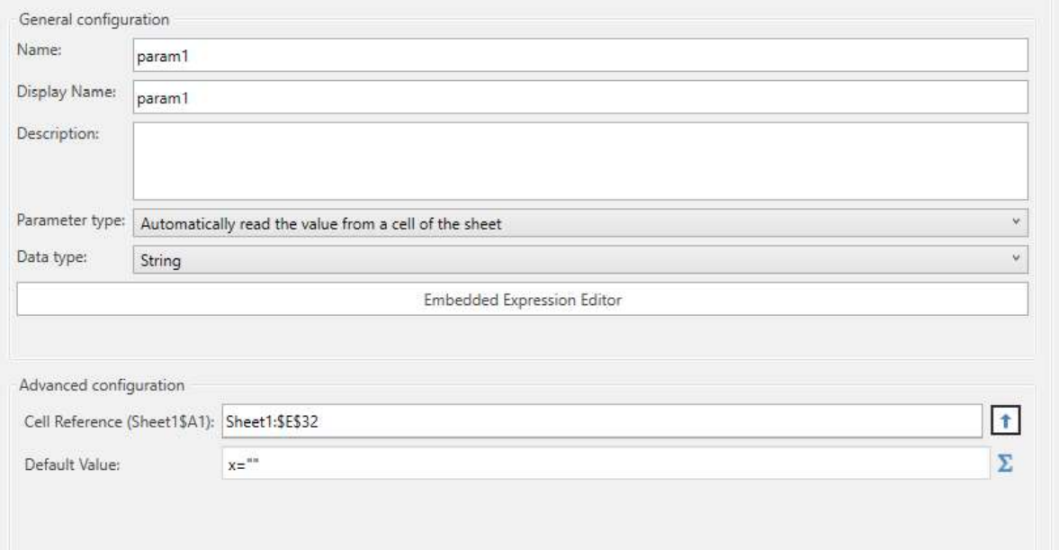
Cell parameter allow you to reference a specific cell on the worksheet.
You can specify which cell you want to target by writing it in the Cell reference textbox, or use the arrow button to select the cell that you want to bind to the parameter.
You can also specify a default value.
The cell parameter cannot reference others parameter.
When dealing with a cell parameter is up to you to choose the appropriate data type, if you’re planning to write integers in the cell occupied by the parameter, you should set the data type to Int.
You can add and remove cell parameters with the command available in the ReportWorX ribbon.
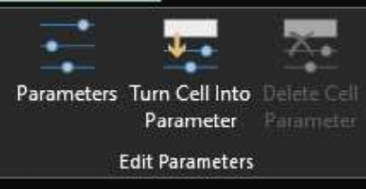
The tag parameter is like the manual parameter, but instead of selecting a value, it lets you select a tag.
Tag parameters are always going to show up in the parameters’ selection window the download operation if they are used in the report.
Tag parameter can be used in the realtime / historical data source tag to choose at download time the tag that you want; note that the historical data source must have the column style set to Extended. Since dataset data source’s headers are dependent upon the tag, you can’t use a tag parameter with a dataset data source.

The local machine parameter does not allow you any configuration, it is going to automatically read the local machine.
The local machine parameter does not allow reference to other parameters since there is no expression, user local machine parameters can be referenced by other parameters.
If you are running ReportWorX on the server machine, local machine parameter and server machine parameter are going to return the same value.
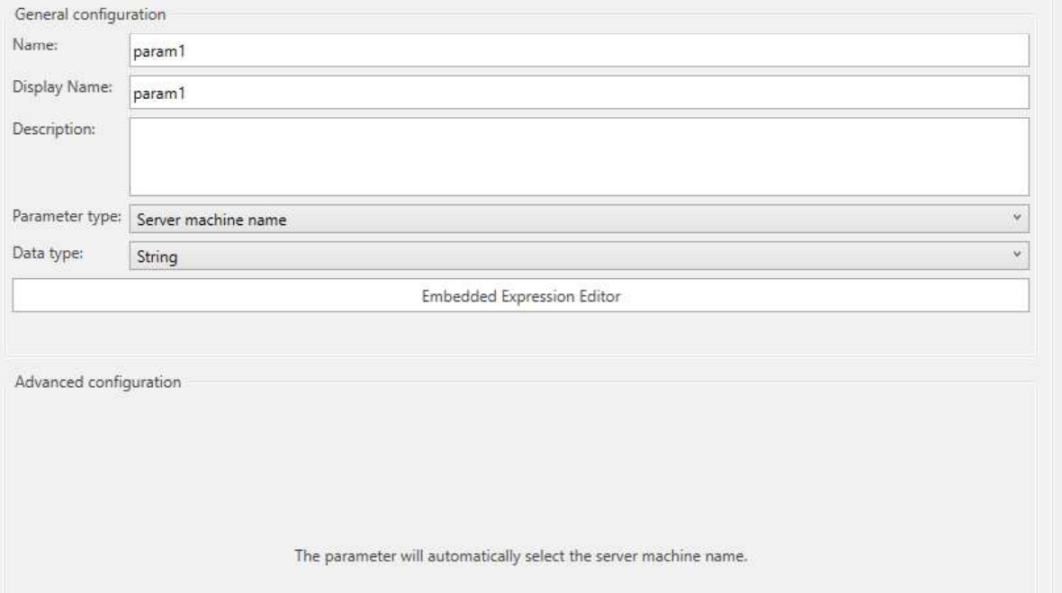
The server machine parameter does not allow you any configuration, it is going to automatically read the server machine.
The server machine parameter does not allow reference to other parameters since there is no expression, user local machine parameters can be referenced by other parameters.
If you are running ReportWorX on the server machine, the local machine parameter and the server machine parameter are going to return the same value.